Australia So Much to See
Kimba is a town that claims to be “half way across Australia”. This is not a factual claim, with Ceduna being nearer to the half way point either ‘as the crow flies’, or by road. There is a large statue of a pink and grey galah in the centre of town.
See more of our Eyre Highway trips through the Eyre Peninsula in the following links.
South Australia's reserves of iron ore lie in the Middleback Ranges on Eyre Peninsula. The principal ore bodies being Iron Monarch,
Iron Knob, Iron Prince, Iron Baron, Iron Knight, Iron Princess, Iron Queen, Iron Chieftain, Iron Duchess and Iron Duke.
Today Iron Knob is widely recognised as the first commercial iron ore mine in Australia. The Iron Knob deposit was the largest in Australia.
Iron Knob town sits in front of hill that was once the Iron Knob (at right)
Silo art on the Viterra grain silos was completed in September 2017 by artist Cam Scale. Painting took 26 days using 200 litres
of paint. The artwork was commissioned through Juddy Roller by the Kimba Community Development Arts Programme.
Funding from Country Arts SA, Grants SA, Foundation for Rural and Regional Renewal, EP Community Foundation, business sponsorships and community donations. Project funding from the District Council of Kimba.
The silos are floodlit at night, and look even more
stunning under lights.
Kimba is the largest of these Eyre Highway wheatbelt towns, and a major grain receival point. Kimba was established in 1915. The name is derived from the Aboriginal word, with the meaning of "Bush Fire".
Pastoral leases were held from 1872
until pioneer farmers grew the first crops in 1908. The Kimba district is now one of the major wheat producing areas in South
Australia. The town is welcoming, and offers free camping at two locations. A convenient place to stock up the larder when on
the Eyre Highway.
The local community conducts tours of the mine which leave the Visitor Centre between 9.15 am - 12.15 pm and from 1.15 pm - 2.45 pm
phone: (08) 8646 2129 or after hours 0439 302 671 to book.
Arrium, formerly known as OneSteel when it was spun off from BHP
in 2000, decided it wanted to resume mining at Iron Knob in 2013. Arrium's mine only has a ten year lifespan. "I'm only
hoping it will bring more people who would like to live in Iron Knob," says resident Jill Szkolka.
"People here are really
tough, the town is run by volunteers and everyone pitches in and helps each other.”
The first mineral claim in the area was pegged by the Broken Hill Proprietary Company in 1897. Mining commenced in 1900 and iron ore
was transported by bullock wagon to Port Augusta then by rail to Whyalla and ship to Port Pirie where it was used as a flux in the
lead smelter there. The iron smelters were established at Port Pirie in 1888.
But were BHP the first? Other sources
state Iron Knob was first exploited by Mount Minden Mining in 1880 but they couldn't keep up production or pay the rent so it was
taken over by BHP in 1896. BHP started mining in 1899 when their smelters at Port Pirie required ironstone as a flux to smelt
the silver-lead ores from Broken Hill. BHP mined Iron Knob from 1899 to 1998. By 1915 the town of Iron Knob was proclaimed.
Quarrying for iron at Iron Knob and Iron Monarch ended in 1998. Iron Knob is now 150 metres lower than it was in 1880
as a result of mining. All that can be seen from the road is a large multi-coloured slag heap (below right) which surrounds
the open cut mine.
In 2005 when we tour Eyre Peninsula and the Gawler Ranges
In 2006 when we climb Mount Wudinna, claimed by locals to be the second
largest monolith in Australia.
Resources
We have visited Ceduna several times, for fuel, shopping and sightseeing. Our first visit in 2005
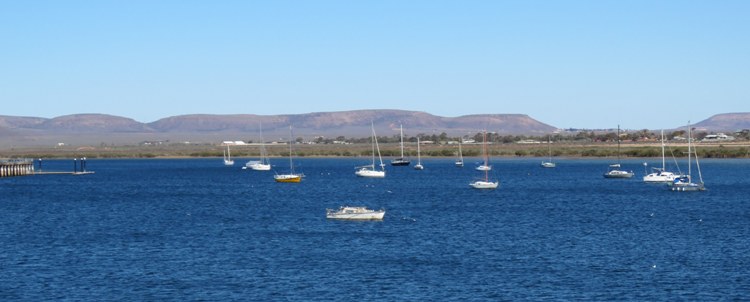
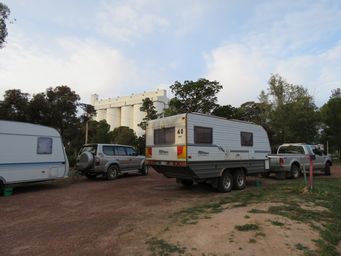
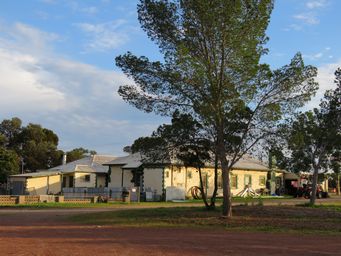
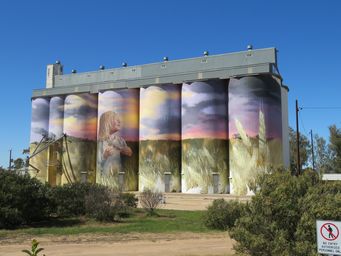
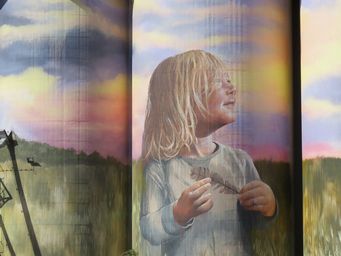
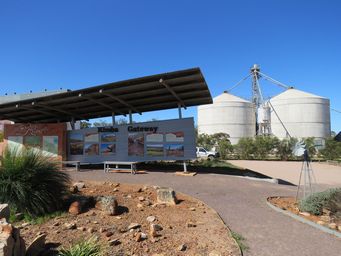
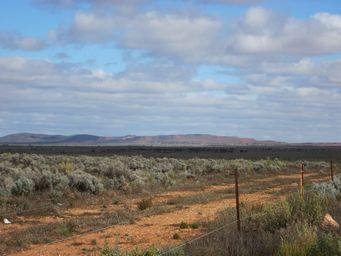
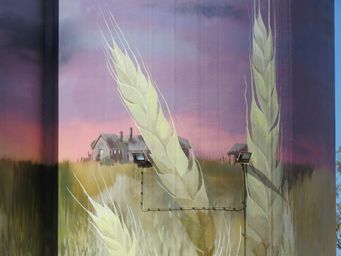
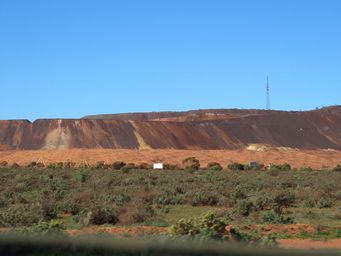
This time we chose to stop overnight at the tiny town of Poochera, which has little more than grain receival bins, a few houses and
a hotel. The roadhouse had closed in June 2019. There is an oval and sports facilities north of the town. A small
museum run by the Historical Society is only open on Wednesdays, or by arrangement.
The hotel has a small caravan park
with six powered sites and a few unpowered spaces for tents or small campervans, and old basic amenities (above left). The large
old hotel entrance and quaint bar is accessed from Barnes Street on the northern side. Since the closure of the Roadhouse, the
hotel now acts as Australia Post agency. The publican was welcoming and chatty.
When seeking accommodation in 2004,
it was getting dark when we tried the small Eyre Highway towns from west to east to find a motel or hotel room. We saw the old
hotel in darkness from the main street and thought it looked derelict and deserted so we moved. The publican assured me it would have
been running in 2004, under different ownership, had we known to go to the other side for the entrance.
While the rooms
still appeared empty (unlit in the evening), it now appeared neat and well maintained (rear of hotel in the early morning light).
Poochera has a large ant statue by the highway, representing the rare Dinosaur Ant which is found in the area. Thought
extinct, this ant was re-discovered in the area in 1977. Unlike other ants, these sting like a wasp, and dates back around 70 million
years.
Camping and Public Dump Points
Port Augusta.
Public dump point, corner Augusta Highway and Northern Power Station Road.
Spear Creek CP $30 powered, serviced
sites, dump point. Bush style park, quiet and well run, at the base of range 25 kilometres south east of Port Augusta
Sports Club,
Power Station Road east side of Port Augusta. Self contained only, $7.
Augusta Caravan Park, Stirling North, $25 powered, $20
cash, serviced sites
Shoreline Caravan Park, north side, on gulf $29 - $35, dump point
Discovery Parks, north side of town, from $40,
dump point
Nuttbush Caravan Park, 40 k west of PA, $25, $24, some highway noise
Iron Knob have a community run campground a little way
off the highway being a few hundred metres along the road to Whyalla. Toilets and a cold shower, public dump point, all for
a donation.
Lake Gillies Conservation Park. A track heads due north from the Eyre highway approximately 15 kilometres
east of Kimba. Ten kilometre track to southern part of the salt lake is caravan suitable. No facilities.
Eyre
Highway through the Eyre Peninsula, many rest areas are large and can get well back from the highway. There are some old school sites,
also old gravel dump sites. All unserviced.
Kimba
Free camp near highway with toilets and drinking water.
Donation camp
by showground, with toilets, showers $1 for two minutes, public dump point close by. Honesty box for donations, which are used
to improve the facilities. Away from highway.
Kimba Motel Caravan Park. Serviced sites next to motel beside highway. $30 powered, $27 seniors card concession.
Kyancutta, rest area alongside store at corner of Eyre Highway and Elliston Stock
Route. Toilets close by.
Wudinna showground, toilets, power and water. Self registration $15 powered,
$10 unpowered.
Minnipa Apex Park alongside highway, toilets. Donations appreciated. Public dump point at sports
ground.
Poochera Hotel Caravan Park, One street back from highway behind silos. Six powered bays plus a few small unpowered
(tent) sites, basic amenities including laundry. $25 powered, $20 unpowered.
Wirrulla Caravan Park, community managed, toilets
and shower, $15 pay at store across the road or at hotel, key for amenities. Some powered outlets, and council is adding more,
with donation requested if using power.
Ceduna – five caravan parks:
Shelly Beach Caravan Park, close to beach four kilometres south
of Ceduna, serviced sites, dump point. $34.50 powered. $26 unpowered, $15 fully self contained.
Ceduna Foreshore
Cavan Park, centre of town, serviced sites, dump point. $35 powered.
Big4 Ceduna Tourist Park, in a main street, serviced
sites, dump point. $27 powered.
A1 Caravan Park, in a main street, older serviced sites. $22 powered, $18 unpowered.
Ceduna Airport Caravan Park, older serviced sites, primitive dump point. $28 unpowered. On highway but behind a block
of units which helps reduce traffic noise. Airport quiet at night.
Public dump point near BP Roadhouse on north western
entrance to Ceduna.
Penong Caravan Park, 73 kilometres west of Ceduna. A lovely caravan park, set at back
of town, so quiet. Near Nullarbor link Windmill hole. Serviced sites and dump point. $30 powered, $25 unpowered. See full details
Cohen Old School Site is worthy of mention for an overnight stop. Tracks and plenty of flat open space for
camping, set back from the highway 14 kilometres east of Penong. No facilities. (Photos next page).